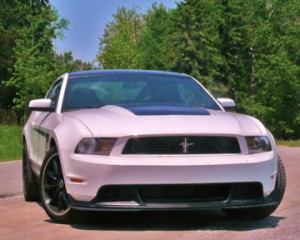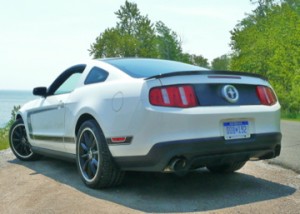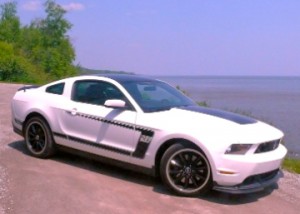2012 Boss 302 pays tribute to 1970 icon
By John Gilbert
There was a little deja vu when the 2012 Ford Mustang Boss 302 first appeared for a one-lap test drive. We were gathered at the spring Midwest Auto Media Association (MAMA) Rally at Road America in Elkhart Lake, Wis., and among the gathered cars for media hot laps was a glistening white Mustang Boss 302. It was particularly glistening because a torrential downpour hammered the area all day. But it didn’t matter. Even driving moderately to keep the high-powered Mustang under strict rein, it was a thrill.
A month later, the very same Mustang — white with its bold black identifying stripes — was delivered to Minneapolis for a week-long test-drive to the North Shore area of Lake Superior, and the weather was fantastic. So was the car.
Ford took its already-strong and still new dual-overhead-camshaft 5.0-liter V8 from the normal Mustang and thoroughly reworked it internally, refining valves, intake and exhaust ports, camshafts, crankshaft, and even the oil pan. Virtually all parts are lighter and stronger for increased capacity against an anticipated increased load. The 5.0 delivers 402 horsepower standard, and 412 in GT form, while the Boss 302 turns out 444 horsepower, with 380 foot-pounds of torque. The added power is easily managed with a 6-speed manual shifter, a short-throw, smooth-shifting gem.
The Boss 302’s price was $42,990, including the heavy-duty MT82 manual transmission, and the Torsen limited-slip differential, plus real Recaro sports bucket seats, in cloth, but it did not come with the widely publicized Sync system that gives almost all new Ford products amazing electronic connectivity. No such voice control, no navigation system, or satellite radio, and I couldn’t coax my iPod to function, either. Apparently it’s assumed that anyone choosing such a strong performer would know where they’re going and wouldn’t appreciate any electronic distractions.
Together with some serious suspension upgrades, including the ability to adjust the shock absorbers for firmer suspension, there are some really special features. My son, Jack, looked underneath the car and noticed two complete sets of dual exhaust pipes.
The secondary pipes cut off near the wheel-wells, and they handle overflowing exhaust, although if the owner wanted to go out to the sort of “track day†opportunities most road-racing tracks now offer, it would be probably be pretty easy to redirect the exhaust for added straight-through power. Such track-day performance also could make best use of the firmer shock settings, and the speed-sensitive electric steering can be set for easy to more resistant wheel feel.
As it stands, the new Boss 302 runs swiftly, handles exceptionally well, stops abruptly, and definitely lives up to its heritage. Good thing, too, because the name Boss 302 demands exceptional performance.
In its never-ending pursuit to keep its pony-car ahead of the herd, Ford has added Mustang models on a nearly annual basis recently, from assorted Shelby and GT models, to specialty models such as the Bullitt, named after the movie of the same name, which included legendary chase scenes in which Steve McQueen raced through the streets of San Francisco. Ford has been able to continue the specific, if subtle, special editions to keep the Mustang current, not missing a beat since its 1964 origin.
But the Boss 302 signals the heritage of truly high-performance Trans-Am racing Mustangs. Built only in 1969 and 1970, the Boss 302s became a company icon, right up there with the LeMans-winning GT-40, and was the closest to a race car Ford ever made in a mainstream vehicle.
Ford’s impressive job building the latest Mustang, with its new DOHC V6, and its all-new 5.0 DOHC V8, made it pretty certain the Boss would connect the dots. There is a lot of the old exhilaration every time you punch the throttle, shift the gears, or zip around a tight curve without wavering from the flat and stable attitude. I’m ready for the red key.
In the late 1960s, pony-cars were a breakthrough for American cars. The “bigger is better†mentality had filled our driveways with large cars that were, pretty much, tanks. Midsize cars were better, but the world of performance cars changed completely with the first Mustang in 1964. It was an immediate classic — lightweight, with a long hood, short rear deck, 2-plus-2 seating, and either a mild but economical 6 or a hot but small V8. Chevrolet followed with the Camaro, Chrysler with the Dodge Challenger and Plymouth Barracuda, Pontiac had the Firebird, and even American Motors got into the act, with the Javeliln. All were similar in size, shape and purpose. And all of them went Trans-Am racing. They were pony-cars, light and agile ponies alongside the midsize horses or full-size plow-horses.
Covering auto racing in those days included the Sports Car Club of America’s Trans-Am series, one of the most exciting, closely contested road-racing series ever concocted, much closer to true street machinery than something like NASCAR is today. Everybody was in it. Roger Penske, and his engineer-driver Mark Donohue, led the Camaro attack, while the Dodge Challenger had Sam Posey behind the wheel, and Plymouth’s Barracuda had Swede Savage driving for Dan Gurney. Bud Moore ran the Mustang team, with the legendary Parnelli Jones and George Follmer as drivers.
All the Mustang needed was a new and more potent engine beyond the outgunned 260 and 289 V8s, and Ford engineers created a masterpiece — a 5-liter, 302 cubic inch V8, with forged steel crankshaft, four-bolt main bearings, solid valve lifters, a deep-set oilpan, special short-skirted pistons and special valves. It was about as good as a pushrod engine could be, advertising 290 “wink-wink†horsepower. It was a 3,000-pound car, and anything with more than one horsepower to 100 pounds called for an insurance hit. So Ford understated its power, despite dyno tests showing the engine closer to 320 or 330 horsepower.
The 1969 Boss 302 was very good, with its quad headlights, narrow grille and three-sided rectangular side stripes, but the 1970 was an excellent update, with a bolder stance, larger single headlights, and the more distinctive side stripe. Parnelli Jones challenged Donohue’s Camaro in 1969, then won the 1970 championship with a remarkable display of driving skill, and an exceptional car.
The 2012 Boss 302 flashed me back to early summer of 1970. I had tested all the pony cars, and we made a family decision to buy one. I liked the Camaro, and the Challenger, and I really liked the looks of the Barracuda, but in objective analysis, the Mustang Boss 302 stood apart, as tight as the Camaro, with the most sophisticated and impressively refined balance of power and agility. It cost a staggering — at the time — $5,000. I hustled down to the Saint Paul Ford plant to help unload the brand new 1970 Ford Boss 302 Mustang from the rail car that brought it from Detroit. The urgency was partly because it was the first and only car I ever ordered factory-direct.
A bigger reason was that my wife, Joan, son Jack, and I, were departing the next day on an epic vacation trip. With a lightweight fold-down tent trailer, our plan was to hook it up to the Boss and drive directly to Toronto, where I would write about the season’s first Can-Am race at Mosport Park. Next, we would drive and camp over the following week, reaching Long Island in time for a Trans-Am race at Bridgehampton. Then, with another week to go, we would drive north into Quebec, camping in the Laurentian Mountains until the weekend, when I would cover the next Can-Am race, at St. Jovite.
It was an awesome trip, with indelible memories for all of us. The Boss 302 was medium blue, with that black stripe angling down behind the front wheel-wells and then shooting straight back, shaped like an enlarged hockey stick. The black stripe was a 3M glass-bead marvel, because when light hit it, it reflected white, bright as a highway sign.
The next year, 1971, Ford redid the Mustang, making it a foot longer, and offered a “Boss 351†with similar revisions to its Cleveland 351 cubic inch engine. It had more power, on paper, and George Montgomery, who built Donnybrooke Speedway in Brainerd as his own high-speed dream, bought a black one, partly because he liked my Boss 302 so much. At a race that year, Montgomery had his public address announcer say that he and I would run a match race during the noon lunch-break. My car needed a tune-up, and I was worried about being outgunned, but not only did my Boss 302 beat his new Boss 351, but I was still in third gear at the end of the quarter-mile.
We owned the car through a couple of accident-induced revisions, and finally sold it 30 years later. Technology had overtaken the original Boss 302’s whistling, high-revving pushrod engine design. The new 5.0-liter Ford engine with dual overhead camshafts, variable valve-timing, and all the other latest technology parts, sets a new standard. And revising it to form the new Boss 302 is a superb example of an All-American pony car, with future-retro styling that honors its 1970 model heritage.
The new car’s exterior design graphics are my only complaint. The base Mustang V6 has large single headlights, while the GT has four headlights, and while they are large, they are positioned one outside and one inside the grille on either side — making the GT look a lot like the 1969 Mustang, and its 1969 Boss 302 spinoff. In 1970, the Boss 302‘s improvements were set off by an exterior featuring larger single headlights, a bold grille, a blacked-out rear end, and the hockey-stick-on-its-side-shape side graphics.
The 2012 Boss 302 has been refined to differentiate from the GT by its large single headlights and grille, and blacked-out rear panel, which makes it look about as different as the 1970 did from the 1969. The side graphics come in various color combinations, all of them striking, and are virtually identical to the horseshoe-on-its-side 1969 Boss, even though the new car is a stunning replica of the 1970 Boss 302. So But the new Boss 302 mimics the 1970’s appearance, with graphics identical to the 1969. Ford needs to bring back one design consultant to oversee such things, old enough to appreciate the heritage of such a true company icon.
The new car will blaze its own contemporary trail. It even comes with two ignition keys, one silver the other red. The silver one makes the car work perfectly; the red one is for those track days or other high-performance desires, because merely inserting it and turning on the Boss 302 also adjusts all the electronic settings for all systems to be on high-performance. The test car I got had only the silver key. Oh, darn. Guess I’ll have to try to get it for another week.
Comments
Tell me what you're thinking...
and oh, if you want a pic to show with your comment, go get a gravatar!





 John Gilbert is a lifetime Minnesotan and career journalist, specializing in cars and sports during and since spending 30 years at the Minneapolis Tribune, now the Star Tribune. More recently, he has continued translating the high-tech world of autos and sharing his passionate insights as a freelance writer/photographer/broadcaster. A member of the prestigious North American Car and Truck of the Year jury since 1993. John can be heard Monday-Friday from 9-11am on 610 KDAL(www.kdal610.com) on the "John Gilbert Show," and writes a column in the Duluth Reader.
John Gilbert is a lifetime Minnesotan and career journalist, specializing in cars and sports during and since spending 30 years at the Minneapolis Tribune, now the Star Tribune. More recently, he has continued translating the high-tech world of autos and sharing his passionate insights as a freelance writer/photographer/broadcaster. A member of the prestigious North American Car and Truck of the Year jury since 1993. John can be heard Monday-Friday from 9-11am on 610 KDAL(www.kdal610.com) on the "John Gilbert Show," and writes a column in the Duluth Reader.